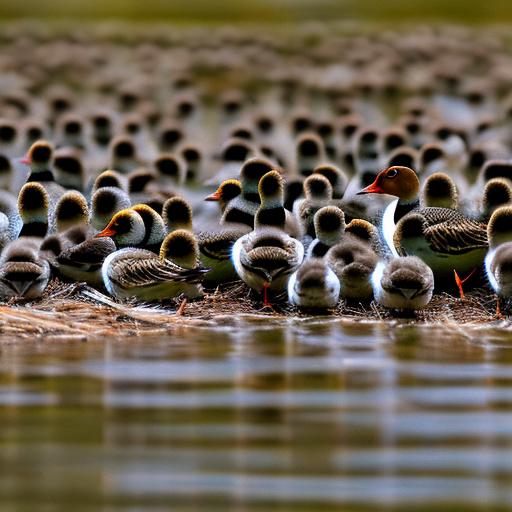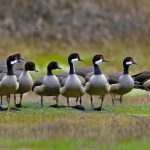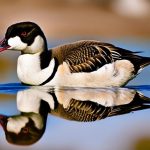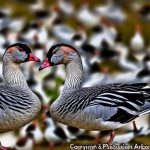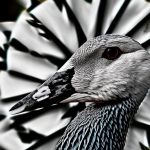Geese are large waterfowl birds that are known for their distinctive honking sound and V-shaped flying formation. They are found in various parts of the world and are known for their strong family bonds and protective nature. Geese mate for life and raise their young together, making them fascinating creatures to study and observe.
Understanding geese nesting habits is important for several reasons. Firstly, it allows us to appreciate the complexity of their behaviors and the effort they put into raising their offspring. Secondly, it helps us understand the challenges they face in the wild and how we can help protect them. By gaining knowledge about geese nesting habits, we can ensure that their nesting sites are preserved and that their young have a safe environment to grow and thrive.
Key Takeaways
- Geese are known for their strong family bonds and protective parenting behaviors.
- Geese typically nest on the ground near water sources, and their nests are often made of grasses and other plant materials.
- Different species of geese have varying nesting preferences, with some preferring to nest in trees or on cliffs.
- Geese choose nesting sites based on factors such as safety, accessibility, and availability of food and water.
- Geese incubate their eggs for around 25-30 days, and both male and female geese play a role in caring for their young after hatching.
Nesting Habits of Geese
Geese typically nest on the ground, often near bodies of water such as lakes, ponds, or rivers. They prefer areas with tall grasses or vegetation that provide cover and protection for their nests. Geese nesting season usually begins in early spring, with females laying a clutch of eggs in their chosen nesting site.
The female goose constructs the nest using materials such as grass, leaves, and feathers. She creates a shallow depression in the ground and lines it with these materials to provide insulation and cushioning for the eggs. The male goose stands guard nearby, keeping watch for any potential threats.
Different Geese Species and Their Nesting Preferences
There are several different species of geese, each with its own unique nesting preferences. For example, Canada geese prefer to nest near bodies of water but will also nest in urban areas such as parks or golf courses. Snow geese, on the other hand, prefer nesting in Arctic tundra regions where they can find suitable vegetation for their nests.
Different geese species also have different clutch sizes, with some species laying more eggs than others. For example, Canada geese typically lay 4-7 eggs, while snow geese can lay up to 5-6 eggs. Understanding these differences in nesting preferences and clutch sizes is important for conservation efforts and ensuring the survival of different geese species.
How Do Geese Choose Nesting Sites?
Geese choose nesting sites based on several factors. One of the most important factors is safety. They look for areas that provide protection from predators such as foxes or raccoons. Tall grasses or vegetation can provide cover and make it harder for predators to spot the nest.
Accessibility is another important factor. Geese prefer nesting sites that are easily accessible to water, as they rely on it for food and protection. They also prefer areas with ample food sources nearby, such as grasses or aquatic plants.
What Do Geese Use to Build Their Nests?
Geese use a variety of materials to build their nests. The female goose collects grass, leaves, and feathers to line the nest and provide insulation for the eggs. She arranges these materials in a circular shape, creating a shallow depression in the ground.
The structure of the nest is important for egg incubation. The materials used by geese help regulate the temperature and humidity inside the nest, creating an optimal environment for the eggs to develop. The female goose will continue to add materials to the nest throughout the incubation period to maintain its structure and ensure the eggs are well-protected.
The Incubation Period of Geese Eggs
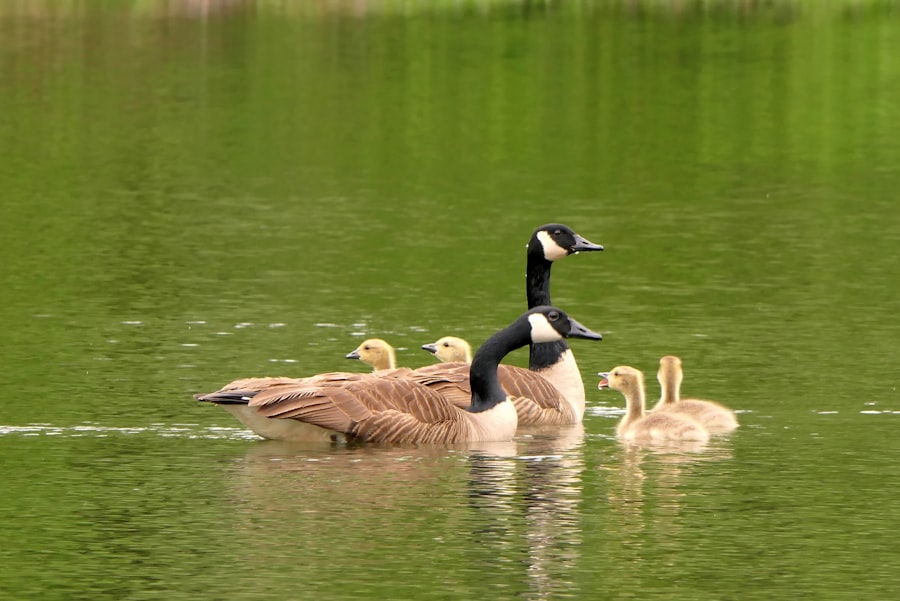
The incubation period for geese eggs varies depending on the species. On average, it takes about 25-30 days for goose eggs to hatch. During this time, the female goose will remain on the nest, rarely leaving except to feed or drink.
Temperature and humidity are crucial factors for successful incubation. The female goose uses her body heat to keep the eggs warm, rotating them regularly to ensure even heat distribution. She also uses her feathers to cover the eggs and protect them from the elements.
Hatching and Parenting of Baby Geese
When the eggs are ready to hatch, the goslings use a small egg tooth on their beak to crack open the shell. They then emerge from the nest, often with the help of their parents. The goslings are covered in down feathers and are able to walk and swim shortly after hatching.
The parents play a crucial role in caring for and protecting their young. They provide warmth, guidance, and protection from predators. The goslings stay close to their parents, learning important survival skills such as finding food and avoiding danger.
The Role of Male and Female Geese in Raising Their Young
Male and female geese have different roles in raising their young. The female goose is primarily responsible for incubating the eggs and caring for the goslings during their early stages. She stays with them constantly, providing warmth and protection.
The male goose plays a supportive role, standing guard near the nest and protecting it from potential threats. He also helps guide the goslings and teaches them important skills such as flying and finding food. Both parents work together as a team to ensure the survival and well-being of their offspring.
Challenges Faced by Baby Geese in the Wild
Baby geese, or goslings, face several challenges in the wild. One of the biggest threats they face is predation. Many predators such as foxes, raccoons, or birds of prey see goslings as easy prey. The parents must be vigilant in protecting their young from these threats.
Environmental factors can also pose challenges for goslings. Harsh weather conditions or lack of suitable food sources can impact their survival. Additionally, human activities such as habitat destruction or disturbance can disrupt their nesting sites and put their young at risk.
Geese and Human Interaction: Protecting Nesting Sites and Young Geese
It is important for humans to understand and respect geese nesting habits to ensure their protection. One way to do this is by preserving and protecting their nesting sites. This can be done by creating protected areas or implementing regulations to prevent disturbance or destruction of these sites.
Educating the public about the importance of geese and their young is also crucial. By raising awareness about the challenges they face and the role they play in ecosystems, we can foster a sense of empathy and encourage people to take action to protect them.
Geese nesting habits and parenting behaviors are fascinating to study and understand. By gaining knowledge about these behaviors, we can appreciate the effort geese put into raising their young and the challenges they face in the wild. It is important for us to protect geese nesting sites and their young to ensure their survival and well-being. By taking action to preserve their habitats and educate others about their importance, we can help ensure a future where geese and their offspring thrive.
If you’re interested in learning more about the fascinating world of poultry, you might also enjoy reading this article on turning a shed into a chicken coop. It provides valuable insights and practical tips for transforming an ordinary shed into a comfortable and functional home for your feathered friends. Whether you’re a beginner or an experienced chicken keeper, this article offers creative ideas to optimize your coop’s interior and create a safe and enjoyable environment for your chickens.
FAQs
What is the habitat of geese?
Geese are found in a variety of habitats including wetlands, grasslands, tundra, and agricultural fields.
Where do geese build their nests?
Geese build their nests on the ground, usually in a well-concealed location such as tall grass or under shrubs.
How many eggs do geese lay?
Geese typically lay between 4-8 eggs per clutch.
How long does it take for goose eggs to hatch?
It takes approximately 25-30 days for goose eggs to hatch.
Where do geese keep their babies?
Geese keep their babies, or goslings, close to them for protection and warmth. They may also lead them to water sources for feeding and swimming.
How long do geese stay with their babies?
Geese will stay with their babies for several months, until the goslings are able to fly and fend for themselves.
What are some predators of goose eggs and goslings?
Predators of goose eggs and goslings include foxes, raccoons, coyotes, and birds of prey such as eagles and hawks.
Meet Walter, the feathered-friend fanatic of Florida! Nestled in the sunshine state, Walter struts through life with his feathered companions, clucking his way to happiness. With a coop that’s fancier than a five-star hotel, he’s the Don Juan of the chicken world. When he’s not teaching his hens to do the cha-cha, you’ll find him in a heated debate with his prized rooster, Sir Clucks-a-Lot. Walter’s poultry passion is no yolk; he’s the sunny-side-up guy you never knew you needed in your flock of friends!

